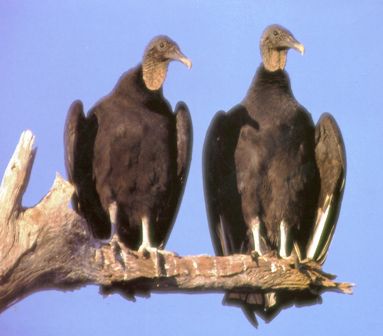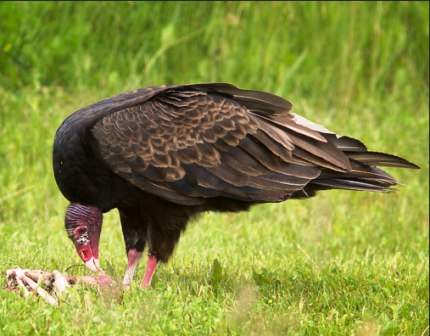Discover Florida Nature
It's time to explore the natural Florida


|
|
|
|
|
 Black
Vulture- The more southern of our two common vulture species,
the Black Vulture flaps its wings rather frequently while it soars. It
is more social than the Turkey Vulture, often traveling in large flocks.
Like the Turkey Vulture, the Black Vulture’s numbers are increasing and
its range is expanding northward in response to global climate changes.
These vultures are found in lowland areas along rivers or in open
habitats in the southern United States and throughout Central and South
America. They rarely inhabit dense forests. The Black Vulture has
adapted well to human habitats and can be seen at garbage dumps,
markets, and fishing docks. Vultures eat carrion in the form of
road-kills or dead cattle in pastures. Black vultures are more
aggressive and may occasionally kill or injure lambs, calves, cows
giving birth, or other incapacitated livestock. These birds soar looking
for carcasses or other scavenger activity. Black
Vulture- The more southern of our two common vulture species,
the Black Vulture flaps its wings rather frequently while it soars. It
is more social than the Turkey Vulture, often traveling in large flocks.
Like the Turkey Vulture, the Black Vulture’s numbers are increasing and
its range is expanding northward in response to global climate changes.
These vultures are found in lowland areas along rivers or in open
habitats in the southern United States and throughout Central and South
America. They rarely inhabit dense forests. The Black Vulture has
adapted well to human habitats and can be seen at garbage dumps,
markets, and fishing docks. Vultures eat carrion in the form of
road-kills or dead cattle in pastures. Black vultures are more
aggressive and may occasionally kill or injure lambs, calves, cows
giving birth, or other incapacitated livestock. These birds soar looking
for carcasses or other scavenger activity. The Black Vulture has a body length of 22 - 27 inches, a wingspan of 4 1/2 - 5 feet, and weighs between 4 - 5 pounds. The head and neck are featherless and the skin is dark gray and wrinkled. The turkey vulture holds its wings in a slight "v" while soaring, whereas the black vulture's wings are held straight. The tail of the black vulture is usually more fanned out in flight and is shorter and broader than that of the turkey vulture. The black vulture flaps its wings more and soars less than its relative. From below it has whitish patches near the tips of the wings, whereas the wings of the turkey vulture lack these patches. New World vultures do not build nests. This species lays its eggs in a cave, between large rocks, at the base of a tree, or in a hollow stump. The female lays 2 eggs that are incubated by both parents for 38 - 45 days. The young vultures fledge at about 3 months old, but stay with the parents in a social group for years. One-on-one, a Black Vulture can be dominated by the slightly larger Turkey Vulture. But, Black Vultures rarely travel alone. Flocks of Black Vultures can quickly take over a carcass and drive the more solitary Turkey Vultures away.  Turkey
Vulture-
Although it has an ugly, bare-skinned face, the Turkey Vulture is
beautiful on the wing. Seldom does this graceful and talented bird flap
its wings as it soars over large areas searching for carrion. The Turkey
Vulture uses its sense of smell to locate carrion. The part of its brain
responsible for processing smells is particularly large, compared to
other birds. Its heightened ability to detect odors allows it to find
dead animals below a forest canopy. The Turkey Vulture roost in a large
group, but usually forages alone, unlike its smaller, more social
relative, the Black Vulture. Although one Turkey Vulture can dominate a
single Black Vulture at a carcass, usually such a large number of Black
Vultures appear that they can overwhelm a solitary Turkey Vulture and
take most of the food. Turkey
Vulture-
Although it has an ugly, bare-skinned face, the Turkey Vulture is
beautiful on the wing. Seldom does this graceful and talented bird flap
its wings as it soars over large areas searching for carrion. The Turkey
Vulture uses its sense of smell to locate carrion. The part of its brain
responsible for processing smells is particularly large, compared to
other birds. Its heightened ability to detect odors allows it to find
dead animals below a forest canopy. The Turkey Vulture roost in a large
group, but usually forages alone, unlike its smaller, more social
relative, the Black Vulture. Although one Turkey Vulture can dominate a
single Black Vulture at a carcass, usually such a large number of Black
Vultures appear that they can overwhelm a solitary Turkey Vulture and
take most of the food. The Turkey Vulture is a large bird. It has a wingspan of 67–72 inches, a length of 25–32 inches, and weighs between two and six pounds. Turkey vultures have dark brown to black plumage; a featherless, purplish-red head and neck; and a short, hooked, ivory-colored beak. The adult turkey vulture's head is small in proportion to its body and is red in color with few to no feathers. It also has a relatively short, hooked, ivory-colored beak. The irises of the eyes are gray-brown; legs and feet are pink-skinned, although typically stained white. The turkey vulture's eye has a single incomplete row of eyelashes on the upper lid and two rows on the lower lid. Its life expectancy in the wild ranges upward of 16 years, with a captive life span of over 20 years being possible. The breeding season of the Turkey Vulture commences in March, peaks in April to May, and continues into June. Courtship rituals of the Turkey Vulture involve several individuals gathering in a circle, where they perform hopping movements around the perimeter of the circle with wings partially spread. In the air, one bird closely follows another while flapping and diving. Eggs are generally laid in the nesting site in a protected location such as a cliff, a cave, a rock crevice, a burrow, inside a hollow tree, or in a thicket. There is little or no construction of a nest; eggs are laid on a bare surface. Females generally lay two eggs, but sometimes one and rarely three. The eggs are cream-colored, with brown or lavender spots around their larger end. Both parents incubate, and the young hatch after 30 to 40 days. Chicks are helpless at birth. Both adults feed the chicks by regurgitating food for them, and care for them for 10 to 11 weeks. |
|
|
Advertise | Privacy Statement | Dog Encyclopedia | Video |Contact | Alaska Nature |
|